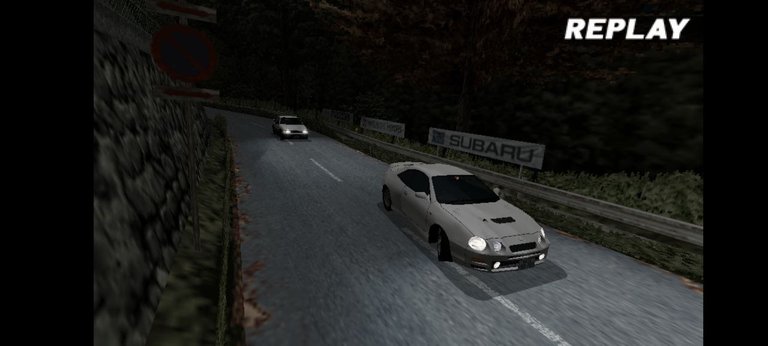

Hey, sorry for the absence - I havent at home for a few days so I didnt have as much of a chance to prepare something new for a while...but here we are again, thanks to one game that I have been playing from start to end on the go with my phone.
Initial D Street Stage is a PSP port of Initial D Arcade Stage 3, having a few things added or removed but in broad strokes, beyond the 30fps framerate and card system for car upgrades [which complicates things] but at least the D-Pad is usable and adjustable for sensitivity.
It has been two years since the last time I actually talked about an Initial D game, that last game being Special Stage which is based off Arcade Stage 2 but is for the PS2. That actually may have been the last time I even played an Initial D game, as the one video I had saved from playing the original Arcade Stage 3 is from three years ago.
Perhaps that is why I felt so out of water when returning to this game a week or two go - I even had struggled at my first attempt with the Two Guys from Tokyo at Akagi, which are the easiest opponents in that track but I ate enough walls to lose enough speed and have to reset early. I smoked them easily afterwards, but point is that in some races that I felt I didnt choke before now had me choke at least once until I could actually beat them.
I have a vague memory of writing off the games after a time as cool but also kinda easy because of the slidey handling with certain cars, mine being the Toyota Celica GT-Four because of SEGA Rally Championship (dont talk me about Miki).
But as I have revisited this game, I have caught on not only on some nuances that I had read of it before, but also felt pushed again to do my best against the harder races and remembering how I had played Street Stage on a real PSP before as well years ago...but I had got walled against one specific opponent.
As of writing this, I have now overcome that one opponent and the two final ones after it, but before going in depth on that journey, I think its time for a proper talk about what makes this game stand out on the feel rather than explaining the modes from the surface, like I saw I did the times I covered Arcade Stage 8 and Special Stage.
Fighting for the advantage
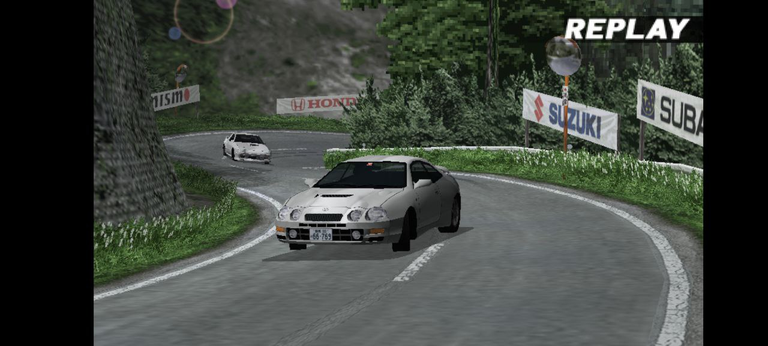
Initial D itself is a series about one-on-one street racing on mountain passes (also refered to as Touge, the japanese term for those), so these game naturally put you in those shoes and wheels of either racing alone in Time Attack for the fastest times in these winding roads, or in races against other characters from the manga in their home courses in the Legend of the Streets mode, the main single player mode.
With that said, note that the physics and rules of this game are different from most racers. It is definitely an arcade racer for sure, but there are things that you could see that are...way different than what you would expect, like the steering being slippery but not ruled by your car getting stuck on a drifting position (so dont be afraid, Scud Race this is not, for better or for worse).
First case being how bumping cars doesnt seem to have any impact - you actually can kind of push cars out with your driving if you are on front and drifting, while bumping the rear of another car wont hurt you either...but you wont be able to get ahead of it unless you find an opening on its sides.
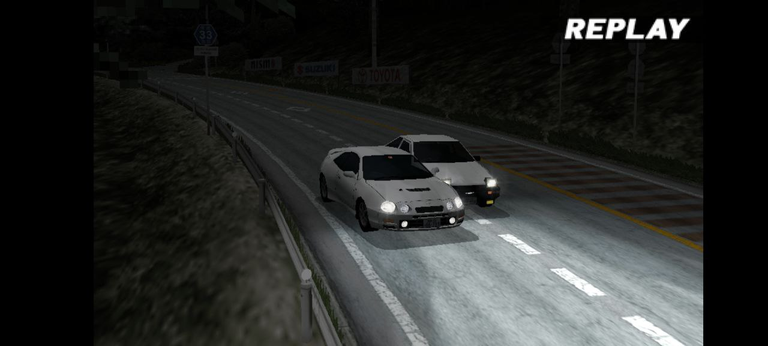
Blocking is something you will learn that is effective as a defensive maneuver when you are playing against the harder AI racers: If they are going faster than you and get behind you, they will only be able to be shaked off on turns where you can get advantage...and if you are stuck on a long straight...well...
...Just keep steering to stay right in front of them until you can have a chance to seek a speed lead. If you let them get ahead, your only chance will be to catch up in turns as well, but you may not want to count on that and reset at once if you let them get TOO far away early in the race if you are on the harder races.
Oh, and one more thing.
Avoid hitting walls head first or else
This warning is for something that might not seem as obvious at it seems. Even though it seems that you can slip around turns at high speed even after a head first wall tap, a sneaky mechanic the game has is that any wall bumps with the front will give you a speed penalty - the harder the crash, the harder the penalty.
It might not sound important, and you may not even mind being stuck at some kilometers below your usual maximum from eating a wall...but the moment you have to fight against the harder racers, those will crush you mercilessly if you do the mistake of bumping walls and stacking speed penalties, as those will noticeably accelerate right behind you and often speed away without chance of catching up because you cut off your acceleration potential.
(Apologies for the buttons on the screen - this was taken directly from playing on the phone)

However, if you can drive around the winding turns well without eating walls with the front bumper, you may actually notice that you can often get chunky distance advantage from your opponents. Your goal is to get those drifts well so that you can have that distance against the tougher opponents.
More distance means that at best, you can keep them even further in the dust - and at worst, you will have a little more room for error if you mess up as long as you can recover in a turn nearby, finish before they catch up to you, or prepare to block them for long enough if they catch up too fast.
This is ESSENTIAL if you even think of completing the game, as the last racers will enforce this a lot - hit a wall and they will catch up instantly while you are stuck at a lower speed and doomed to block until you can try to shake them off in a turn or be forced to restart.
Learning to race home and far from home
There are many tracks available in the game, two of them are real mountain passes known to be difficult in the one or two games they appear in their real forms (Myogi and Usui) but here they were turned into the easy circuit tracks of the game to learn the basics.
But it is in Akagi onwards where you get actual mountain pass racing from start to end, uphill or downhill, and have to get comfortable with timing your drifts accordingly. Irohazaka will test your speed control as you have to constantly be ready for very sharp succesive hairpins, Happogahara will test your drift timing with a few of them being tough, and Shomaru will test your driving on a very thin road for two.
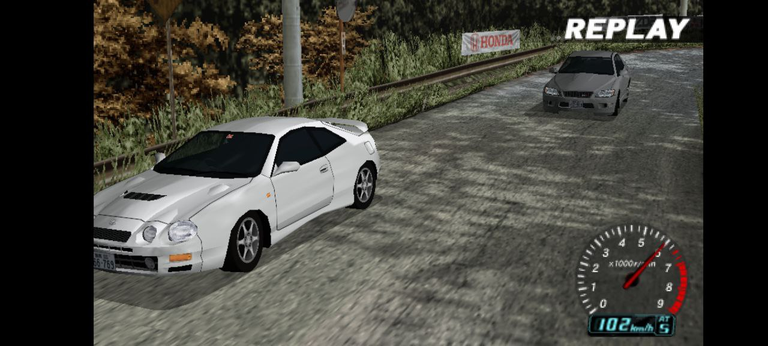
Tsuchizaka will force you to not only apply yourself with braking well before drifts, but also enforce the idea of having to avoid needless wall bumps like the plague as the two last racers of the game, Project D Keisuke and Takumi, will be there as your opponents on the uphill and downhill - only if you beat EVERYONE else (they will be locked otherwise).
And there is also an obstacle on the side of the track halfway through - watch out for that.
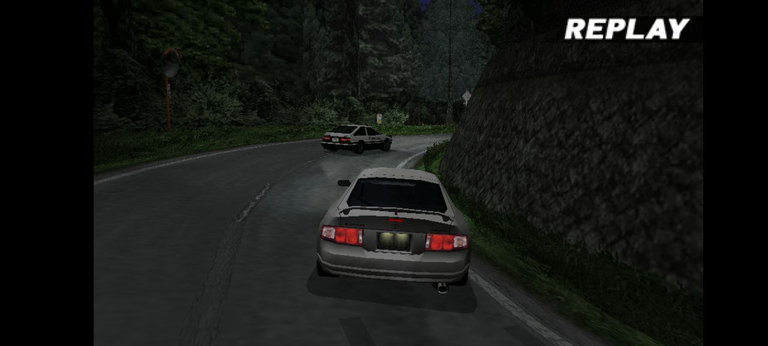
Even Akina, the fourth track in the game, can put you into a crossroad and force you to learn properly how to tackle those turns without making a fool, as not only the first Takumi race awaits there, but also...if you beat Project D Takumi (the last racer)...you will have to race Bunta over there.
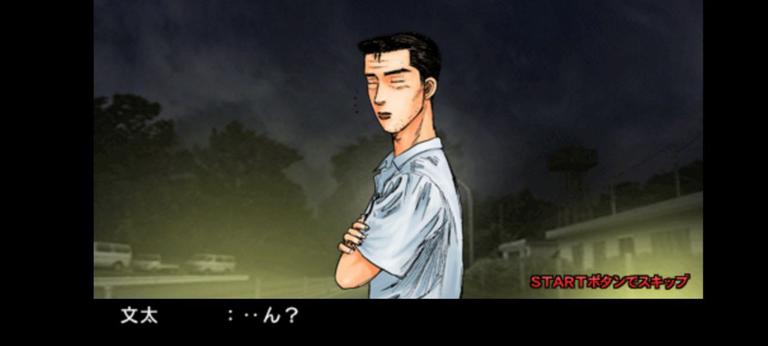
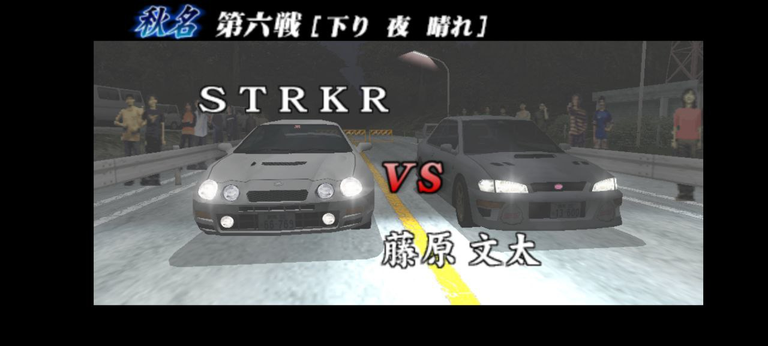
The track IS easier for the most part than what comes later...but you will feel at razors edge with how every small turn will be important because Bunta does NOT leave room for error - even less than the protagonist Takumi himself in this mountain (which makes sense, because Bunta is his dad and in-universe a retired street racing master)
You can get advantage if you tackle the turns well, which will be a visual relief the more you get as you leave behind the old street legend while giving yourself a bit more room for error for later. But mess up early and he wont let go of your bumper until he passes you.
I managed to beat him just barely as I somehow gained a good amount of distance until the last half of the last section. He slowly started getting closer from a mistake I did, fumbled the last drift...and if I didnt lose that race at the last second like a completely devastated fool...
...Thats becuse I managed to just about keep him out from reaching the goal by blocking (look at the rear mirror on the screenshot below, he was RIGHT BEHIND ME). By the skin of my teeth, but I defeated the fastest racer of the game, and with that, earned my staff roll.
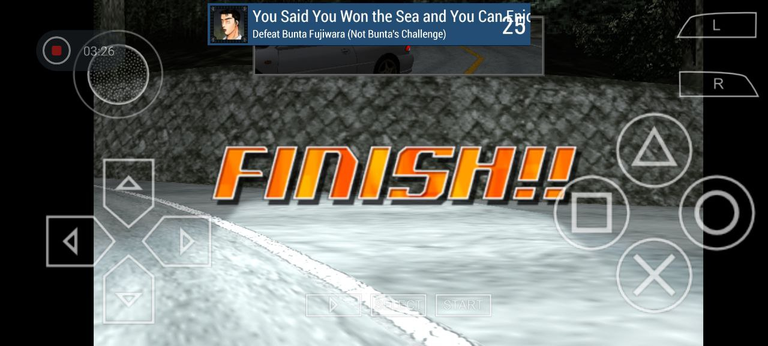
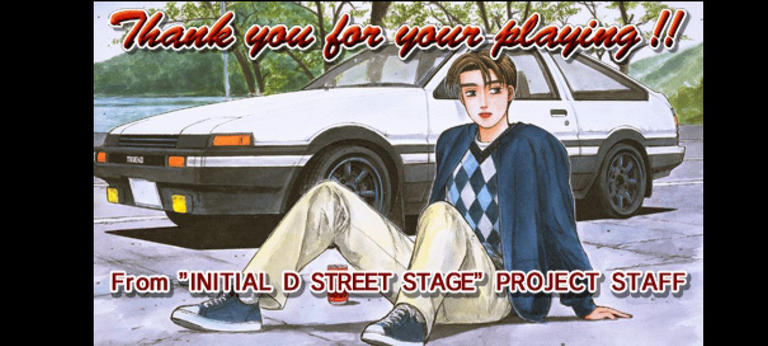
Conclusion
As a standalone game to try out, it is fairly accessible when you get to grips with the controls, which can be increased or lowered in digital sensitivity (apparently doesn't have analog steering despite the PSP analog stick being there?), and even if you feel you may need an Easy mode to get through...there IS one available alongside a Hard mode.
I haven't tried Easy mode, but from what I heard, it can help a lot even at the last races, so if you want to go through it way more laid-back than usual then the option is there. If you want to grit it the classic way though, don't forget that the drivetrain influences the way your car handles, and don't forget the "avoiding walls" tip.
This version was not exported outside of Japan, so by default it is only available in English. But putting aside basic menu translations, looking up what each option does should be enough to navigate through the game.
I will talk about how this game stacks up along Arcade Stages 3 when I talk about it, which I definitely could when the next thing I did after beating this was to play AS3.
There are some nuances that are different there, such as the framerate and higher fidelity visuals making the game be way more impressive as a racer, the analog steering feeling nice but also being very sensitive for beginners...and since I was able to play that on a controller on PC instead of a phone screen, actually explore how the game feels in Manual with how a few techniques are iconic to the first three games (Machinegun Shifting and Eraser).
It has been a fun experience after only having played all of these games in Automatic, more so when the physics allow you to get funky with drifts with better speed control thanks to the gears, but that will be a story for another day.
The one thing I ignored to mention was the card system, in which each finished race will give you a chance to get one out of three cards, some of which can be used for upgrading your car (to the detriment of many, compared to the simpler "play and get points for upgraades" system from the arcade ver.), but I completed the game in Normal difficulty with the stock Celica GT-Four as I couldnt be bothered to look into that...so the game is fully playable even if you ignore that.
In any case...I think that Street Stage may actually be a kind of effective way of learning the Arcade Stage ropes (tackling corners) as by the time you get to the proper Arcade Stage 3 and use Manual Transmission, you may be able to smoke the harder racers with ease thanks to your previous practice
I sure know that because I just one shot Akina Takumi in IDAS3 by a long shot after the last time I fought him there three years ago being a long struggle to take him down.
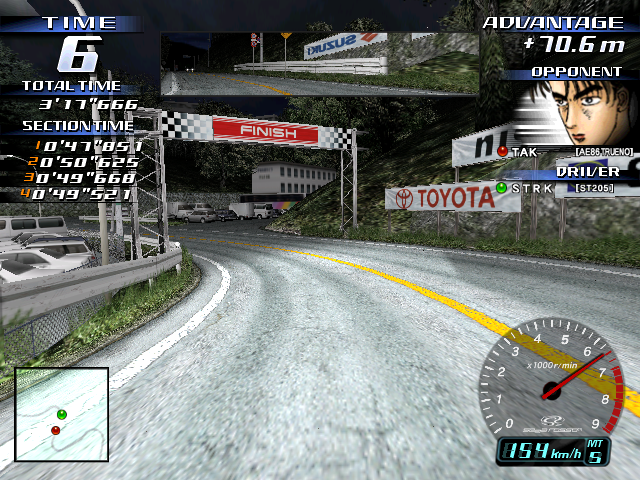
Thanks for reading!

Spanish translation with DeepL. All screenshots were captured by myself.
Español
Hola, perdón por la ausencia - no he estado en casa durante unos días, así que no he tenido la oportunidad de preparar algo nuevo por un tiempo ... pero aquí estamos de nuevo, gracias a un juego que he estado jugando de principio a fin sobre la marcha con mi teléfono.
Initial D Street Stage es un port para PSP de Initial D Arcade Stage 3, al que se le han añadido o quitado algunas cosas pero a grandes rasgos, más allá del framerate a 30fps y el sistema de tarjetas para mejorar los coches [que complica las cosas] pero al menos el D-Pad es usable y ajustable en sensibilidad.
Han pasado dos años desde la última vez que hablé de un juego de Initial D. Ese último juego fue Special Stage, basado en Arcade Stage 2 pero para PS2. Puede que esa fuera la última vez que jugué a un juego de Initial D, ya que el único vídeo que tenía guardado del Arcade Stage 3 original es de hace tres años.
Quizá por eso me sentí tan desorientado cuando volví a este juego hace una o dos semanas. Incluso tuve problemas en mi primer intento con los Dos Tipos de Tokio en Akagi, que son los oponentes más fáciles de esa pista, pero me comí suficientes paredes como para perder velocidad y tener que reiniciar pronto. Después me los cargué fácilmente, pero la cuestión es que en algunas carreras que antes no se me atragantaron, ahora se me atragantaron al menos una vez hasta que pude derrotarlos.
Tengo un vago recuerdo de haber descartado los juegos después de un tiempo por considerarlos geniales, pero también un poco fáciles debido al manejo resbaladizo de ciertos coches, siendo el mío el Toyota Celica GT-Four de SEGA Rally Championship (no me hables de Miki).
Pero cuando he vuelto a jugar, no solo me he dado cuenta de algunos matices que había leído antes, sino que también me he sentido empujado a dar lo mejor de mí en las carreras más duras y he recordado cómo había jugado a Street Stage en una PSP real hace años... pero me había enfrentado a un oponente concreto.
En el momento de escribir esto, ya he superado a ese oponente y a los dos finales que le siguieron, pero antes de profundizar en ese viaje, creo que ha llegado el momento de hablar de lo que hace que este juego destaque en cuanto a sensaciones, en lugar de explicar los modos desde la superficie, como vi que hice las veces que cubrí Arcade Stage 8 y Special Stage.
Luchando por la ventaja

Initial D en sí es una serie sobre carreras callejeras de uno contra uno en puertos de montaña (también conocidos como Touge, el término japonés para estos), así que este juego naturalmente te pone en esos zapatos y ruedas, ya sea corriendo solo en Time Attack por los tiempos más rápidos en estas carreteras sinuosas, o en carreras contra otros personajes del manga en sus circuitos de origen en el modo Legend of the Streets, el modo principal para un jugador.
Dicho esto, ten en cuenta que la física y las reglas de este juego son diferentes a las de la mayoría de los juegos de carreras. Es sin duda un arcade de carreras, pero hay cosas que puedes ver que son... muy diferentes de lo que esperarías, como que la dirección es resbaladiza pero no se rige por que tu coche se quede atascado en una posición de derrape (así que no te asustes, esto no es Scud Race, para bien o para mal).
El primer caso es cómo chocar con los coches no parece tener ningún impacto - en realidad puedes empujar a los coches con tu conducción si estás delante y derrapando, mientras que chocar con la parte trasera de otro coche tampoco te hará daño... pero no serás capaz de adelantarlo a menos que encuentres una abertura en sus lados.

Bloquear es algo que aprenderás que es efectivo como maniobra defensiva cuando estás jugando contra los corredores IA más duros: Si van más rápido que tú y se ponen detrás de ti, sólo podrás esquivarlos en las curvas donde puedas sacar ventaja... y si te quedas atascado en una larga recta... bueno...
...Simplemente mantén la dirección para permanecer justo delante de ellos hasta que puedas tener la oportunidad de buscar una ventaja de velocidad. Si dejas que se adelanten, tu única oportunidad será alcanzarlos también en las curvas, pero puede que no quieras contar con eso y reiniciar de una vez si dejas que se alejen DEMASIADO al principio de la carrera si estás en las carreras más duras.
Ah, y una cosa más.
Evite golpear las paredes de cabeza o de lo contrario
Esta advertencia es para algo que puede no parecer tan obvio como parece. Aunque parezca que puedes derrapar en las curvas a alta velocidad incluso después de un golpe frontal contra la pared, una mecánica furtiva que tiene el juego es que cualquier golpe contra la pared con la parte delantera te dará una penalización de velocidad - cuanto más fuerte sea el choque, más dura será la penalización.
Puede que no parezca importante, e incluso puede que no te importe quedarte atascado a unos kilómetros por debajo de tu máximo habitual por comerte un muro... pero en el momento en que tengas que luchar contra los corredores más duros, esos te aplastarán sin piedad si cometes el error de chocar contra los muros y acumular penalizaciones de velocidad, ya que esos acelerarán notablemente justo detrás de ti y a menudo se alejarán a toda velocidad sin posibilidad de alcanzarte porque has cortado tu potencial de aceleración.
(Disculpas por los botones en la pantalla - esto fue tomado directamente de jugar en el teléfono)

Sin embargo, si puedes conducir bien por las curvas sinuosas sin comerte las paredes con el parachoques delantero, te darás cuenta de que a menudo puedes sacar una gran ventaja de distancia a tus oponentes. Tu objetivo es hacer bien esos derrapes para poder tener esa distancia contra los rivales más duros.
Más distancia significa que, en el mejor de los casos, puedes mantenerlos aún más lejos en el polvo - y en el peor, tendrás un poco más de margen de error si metes la pata siempre y cuando puedas recuperarte en una curva cercana, terminar antes de que te alcancen, o prepararte para bloquearlos durante el tiempo suficiente si te alcanzan demasiado rápido.
Esto es ESENCIAL si siquiera piensas en completar el juego, ya que los últimos corredores harán cumplir esto mucho - golpear una pared y se pondrán al día al instante, mientras que usted está atascado en una velocidad más baja y condenado a bloquear hasta que pueda tratar de deshacerse de ellos en una curva o se ven obligados a reiniciar.
Aprendiendo a correr en casa y lejos de casa
Hay muchas pistas disponibles en el juego, dos de ellas son puertos de montaña reales conocidos por su dificultad en el uno o dos juegos en que aparecen en sus formas reales (Myogi y Usui) pero aquí se convirtieron en las pistas de circuito fáciles del juego para aprender lo básico.
Pero es a partir de Akagi cuando te enfrentas a auténticas carreras en puertos de montaña de principio a fin, cuesta arriba o cuesta abajo, y tienes que acostumbrarte a calcular tus derrapes. Irohazaka pondrá a prueba tu control de la velocidad, ya que tienes que estar preparado constantemente para tomar horquillas muy cerradas, Happogahara pondrá a prueba tus derrapes, algunos de ellos difíciles, y Shomaru pondrá a prueba tu conducción en una carretera muy fina para dos.

Tsuchizaka te obligará no solo a aplicarte con los frenos bien antes de los derrapes, sino también a reforzar la idea de tener que evitar como la peste los golpes innecesarios contra el muro, ya que los dos últimos corredores del juego, Project D Keisuke y Takumi, estarán ahí como tus oponentes en las subidas y bajadas, solo si ganas a TODOS los demás (de lo contrario, estarán bloqueados).
Y también hay un obstáculo a un lado de la pista a mitad de camino - ten cuidado con eso.

Incluso Akina, la cuarta pista del juego, puede ponerte en una encrucijada y obligarte a aprender bien cómo afrontar esas curvas sin hacer el ridículo, ya que allí no solo te espera la primera carrera de Takumi, sino que además... si vences al Proyecto D Takumi (el último corredor)... tendrás que competir contra Bunta allí.


La pista ES más fácil en su mayor parte que lo que viene después... pero te sentirás al filo de la navaja con lo importante que será cada pequeño giro porque Bunta NO deja margen para el error - incluso menos que el propio protagonista Takumi en esta montaña (lo cual tiene sentido, porque Bunta es su padre y en el universo un maestro retirado de las carreras callejeras)
Puedes conseguir ventaja si afrontas bien las curvas, lo que será un alivio visual cuanto más te alejes de la vieja leyenda callejera y te dejes un poco más de margen de error para más adelante. Pero mete la pata pronto y no te soltará el parachoques hasta que te pase.
Me las arreglé para ganarle por poco, ya que de alguna manera gané una buena cantidad de distancia hasta la última mitad de la última sección. Poco a poco comenzó a acercarse de un error que hice, fumbled la última deriva ... y si yo no perdí esa carrera en el último segundo como un tonto completamente devastado ...
...Eso es porque me las arreglé para casi mantenerlo fuera de llegar a la meta mediante el bloqueo (mira el espejo retrovisor en la captura de pantalla a continuación, que estaba justo detrás de mí). Por los pelos, pero derroté al corredor más rápido del juego, y con eso, gané mi rollo de personal.


Conclusión
Como juego independiente para probar, es bastante accesible cuando te haces con los controles, que pueden aumentarse o reducirse en sensibilidad digital (aparentemente no tiene dirección analógica a pesar de que el stick analógico de PSP está ahí...), e incluso si crees que puedes necesitar un modo Fácil para pasártelo... HAY uno disponible junto con un modo Difícil.
No he probado el modo Fácil, pero por lo que he oído, puede ayudar mucho incluso en las últimas carreras, así que si quieres pasártelo de forma más relajada de lo habitual, la opción está ahí. Sin embargo, si quieres hacerlo de la forma clásica, no olvides que la transmisión influye en la forma en que se maneja tu coche, y no olvides el consejo de «evitar los muros».
Esta versión no se exportó fuera de Japón, así que por defecto sólo está disponible en inglés. Pero dejando a un lado las traducciones básicas de los menús, buscar lo que hace cada opción debería ser suficiente para navegar por el juego.
Cuando hable de Arcade Stages 3, hablaré de cómo se comporta este juego, que sin duda podría hacerlo cuando lo siguiente que hice después de superarlo fue jugar a AS3.
Hay algunos matices que son diferentes allí, como el framerate y una mayor fidelidad visuales haciendo que el juego sea mucho más impresionante como un corredor, la dirección analógica sensación agradable, pero también es muy sensible para los principiantes ... y ya que era capaz de jugar que en un controlador en PC en lugar de una pantalla del teléfono, en realidad explorar cómo se siente el juego en Manual con cómo algunas técnicas son icónicos a los tres primeros juegos (Machinegun Shifting y Eraser).
Ha sido una experiencia divertida después de haber jugado todos estos juegos sólo en Automático, más aún cuando la física te permite hacer derrapes con un mejor control de la velocidad gracias a las marchas, pero esa será una historia para otro día.
Lo único que me olvidé de mencionar fue el sistema de cartas, en el que cada carrera terminada te dará la oportunidad de conseguir una de tres cartas, algunas de las cuales pueden usarse para mejorar tu coche (en detrimento de muchos, comparado con el sistema más simple de «juega y consigue puntos para mejoras» de la versión arcade), pero yo completé el juego en dificultad Normal con el Celica GT-Four original porque no me molesté en investigarlo... así que el juego es totalmente jugable incluso si ignoras eso.
En cualquier caso... creo que la fase de calle puede ser una forma efectiva de aprender las técnicas de la fase arcade (tomar curvas), ya que cuando llegues a la fase arcade 3 y uses la transmisión manual, podrás acabar con los corredores más duros con facilidad gracias a tu práctica previa.
Seguro que lo sé porque acabo de derrotar a Akina Takumi en IDAS3 por una gran diferencia después de que la última vez que luché contra él allí hace tres años fuera una larga lucha para derribarlo.

¡Gracias por leer!

Traducción al español hecha con DeepL. Todas las fotos capturadas por mí.
It will be fun to race with multiple cars rather than just 1 though, the road is definitely a challenge if you want something tough
Sounds like such a refreshing dive into the game. Your description of each track captures the thrill and difficulty of the game.
Looking forward to your comparison with Arcade Stage 3 as I believe it’ll be interesting to see how they stack up.